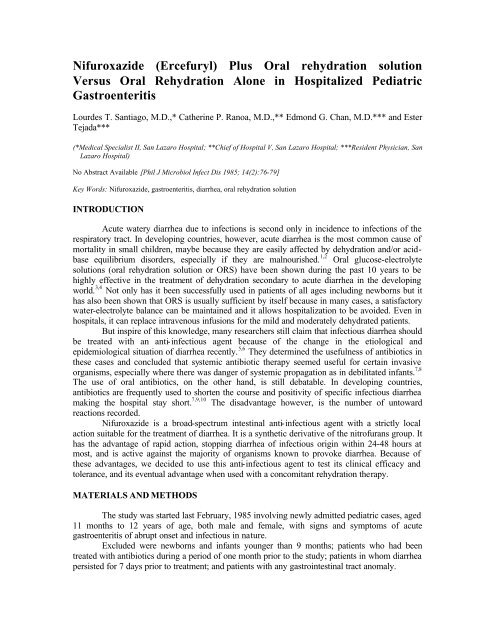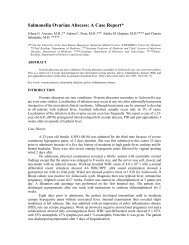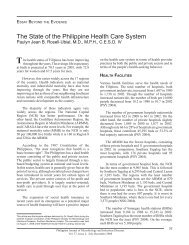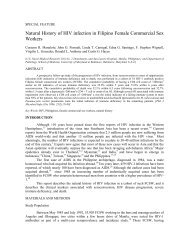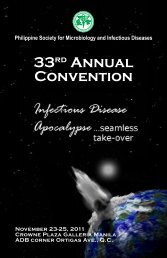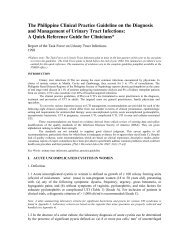Nifuroxazide (Ercefuryl) Plus Oral rehydration solution Versus Oral ...
Nifuroxazide (Ercefuryl) Plus Oral rehydration solution Versus Oral ...
Nifuroxazide (Ercefuryl) Plus Oral rehydration solution Versus Oral ...
Create successful ePaper yourself
Turn your PDF publications into a flip-book with our unique Google optimized e-Paper software.
<strong>Nifuroxazide</strong> (<strong>Ercefuryl</strong>) <strong>Plus</strong> <strong>Oral</strong> <strong>rehydration</strong> <strong>solution</strong><br />
<strong>Versus</strong> <strong>Oral</strong> Rehydration Alone in Hospitalized Pediatric<br />
Gastroenteritis<br />
Lourdes T. Santiago, M.D.,* Catherine P. Ranoa, M.D.,** Edmond G. Chan, M.D.*** and Ester<br />
Tejada***<br />
(*Medical Specialist II, San Lazaro Hospital; **Chief of Hospital V, San Lazaro Hospital; ***Resident Physician, San<br />
Lazaro Hospital)<br />
No Abstract Available [Phil J Microbiol Infect Dis 1985; 14(2):76-79]<br />
Key Words: <strong>Nifuroxazide</strong>, gastroenteritis, diarrhea, oral <strong>rehydration</strong> <strong>solution</strong><br />
INTRODUCTION<br />
Acute watery diarrhea due to infections is second only in incidence to infections of the<br />
respiratory tract. In developing countries, however, acute diarrhea is the most common cause of<br />
mortality in small children, maybe because they are easily affected by dehydration and/or acidbase<br />
equilibrium disorders, especially if they are malnourished. 1,2 <strong>Oral</strong> glucose-electrolyte<br />
<strong>solution</strong>s (oral <strong>rehydration</strong> <strong>solution</strong> or ORS) have been shown during the past 10 years to be<br />
highly effective in the treatment of dehydration secondary to acute diarrhea in the developing<br />
world. 3,4 Not only has it been successfully used in patients of all ages including newborns but it<br />
has also been shown that ORS is usually sufficient by itself because in many cases, a satisfactory<br />
water-electrolyte balance can be maintained and it allows hospitalization to be avoided. Even in<br />
hospitals, it can replace intravenous infusions for the mild and moderately dehydrated patients.<br />
But inspire of this knowledge, many researchers still claim that infectious diarrhea should<br />
be treated with an anti-infectious agent because of the change in the etiological and<br />
epidemiological situation of diarrhea recently. 5,6 They determined the usefulness of antibiotics in<br />
these cases and concluded that systemic antibiotic therapy seemed useful for certain invasive<br />
organisms, especially where there was danger of systemic propagation as in debilitated infants. 7,8<br />
The use of oral antibiotics, on the other hand, is still debatable. In developing countries,<br />
antibiotics are frequently used to shorten the course and positivity of specific infectious diarrhea<br />
making the hospital stay short. 7,9,10 The disadvantage however, is the number of untoward<br />
reactions recorded.<br />
<strong>Nifuroxazide</strong> is a broad-spectrum intestinal anti-infectious agent with a strictly local<br />
action suitable for the treatment of diarrhea. It is a synthetic derivative of the nitrofurans group. It<br />
has the advantage of rapid action, stopping diarrhea of infectious origin within 24-48 hours at<br />
most, and is active against the majority of organisms known to provoke diarrhea. Because of<br />
these advantages, we decided to use this anti-infectious agent to test its clinical efficacy and<br />
tolerance, and its eventual advantage when used with a concomitant <strong>rehydration</strong> therapy.<br />
MATERIALS AND METHODS<br />
The study was started last February, 1985 involving newly admitted pediatric cases, aged<br />
11 months to 12 years of age, both male and female, with signs and symptoms of acute<br />
gastroenteritis of abrupt onset and infectious in nature.<br />
Excluded were newborns and infants younger than 9 months; patients who had been<br />
treated with antibiotics during a period of one month prior to the study; patients in whom diarrhea<br />
persisted for 7 days prior to treatment; and patients with any gastrointestinal tract anomaly.
Forty patients forming 2 groups of 20 each were included by randomization. Treatment<br />
was done as follows:<br />
1st group = received nifuroxazide suspension and ORS in relation to the dehydration<br />
status of the child plus adequate diet (starting with diluted milk diet progressing until resumption<br />
of normal diet. Breast-feeding was not disrupted),<br />
2nd group = received ORS only in function to the dehydration status of the child.<br />
The dosage of nifuroxazide suspension was 660 mg administered in 3 single doses of 220<br />
mg (5 ml suspension) per day until disappearance of diarrheal symptoms and resumption of<br />
normal diet. The <strong>rehydration</strong> therapy was adapted to the child's requirements. Diet was adapted<br />
depending on the appearance of the stool. The first day of normal nutrition was considered as the<br />
time of recovery. Stool or rectal swab culture was done before the start of the treatment and daily<br />
thereafter until the patient was discharged.<br />
The criteria for recovery included:<br />
1. The total necessary quantity of <strong>rehydration</strong> <strong>solution</strong> in milliliters (total amount of<br />
ORS),<br />
2. The resumption of normal diet in days,<br />
3. Shift from frequent watery stools to less frequent stool movements of a more normal<br />
consistency.<br />
Side effects were also noted, as well as the number and reasons for withdrawal, if any.<br />
RESULTS<br />
A total of 104 patients were examined for stool pathogens, out of which forty (40) were<br />
positive for enteric pathogens and forty six (46) negative. Eighteen (18) absconded.<br />
Of the twenty (20) cases from the nifuroxazide group, 13 were males and 7 females. In<br />
the ORS group, 10 were males and 10 females.<br />
Table 1 shows the age group of the patients. As seen, majority belonged to the 1-2 years<br />
age group.<br />
Table 1. Age Group and Sex of the Patients<br />
Age Group M F <strong>Ercefuryl</strong> M F ORS<br />
1 year 2 0 2 0 2 2<br />
1 - 2 8 7 15 7 7 14<br />
3 - 4 2 0 2 0 1 1<br />
5 - 6 0 0 1 0 0 2<br />
7 - 8 1 0 1 0 0 0<br />
9 - 10 0 0 0 1 0 1<br />
11- 12 0 0 0 0 0 0<br />
Total patients 13 7 7 10 20<br />
In many cases of gastroenteritis, the most important parameters in the analysis of results<br />
are the duration of diarrhea, the consistency of the stools observed daily, and the amount of fluids<br />
given. Table 2 shows the duration of diarrhea in days. It will be noticed that the difference<br />
between the two groups is significant. Six patients from the nifuroxazide group had diarrhea for<br />
one day only compared to the 3 patients in the ORS group. Four of the ORS patients still had<br />
diarrhea up to the 4th day of hospitalization against the 3 in the nifuroxazide patients, and 2<br />
patients in the ORS group against none in the treated group up to the 6th day.<br />
During the episodes of diarrhea in children, the consistency of the stools was watery. The<br />
stools gradually or abruptly became formed depending upon the response of the patient to the<br />
treatment given. Table 3 showed the amount of fluids consumed by the two groups. In the treated<br />
group the patients consumed a total amount of 36,600 ml ORS, whereas, in the ORS group the<br />
patients had consumed 62,650 ml ORS or almost twice the nifuroxazide group.
Table 2. Duration of Diarrhea<br />
Day <strong>Ercefuryl</strong> ORS<br />
1 6 3<br />
2 6 6<br />
3 5 5<br />
4 3 4<br />
5 0 0<br />
6 0 2<br />
Total patients 20 20<br />
Table 3. Amount of Fluids Given<br />
Milliters of ORS Amount Used <strong>Ercefuryl</strong> Amount Used ORS<br />
100 - 900 600 6 patients 3000 5 patients<br />
1000 - 1900 5000 5 " 8400 7 "<br />
2000 - 2900 8000 4 " 4000 2 "<br />
3000 - 3900 6000 2 " - 0 "<br />
4000 - 4900 - 0 " 9000 2 "<br />
5000 -5900 10000 2 " 5500 1 "<br />
6000 - 6900 - 0 " 6000 1 "<br />
7000 - 7900 7000 1 " - 0 "<br />
12250 - - 0 " 12250 1 "<br />
Total 36600 ml 20 patients 62650 ml 20 patients<br />
Resumption to normal diet is also an important parameter in gauging if the patient is<br />
getting well. 11,12 Table 4 showed the day when the two groups resumed their normal diet. In the<br />
treated group, all 20 cases resumed normal diet on their 3rd day of confinement. In the ORS<br />
group, majority resumed normal diet on the 2nd day as in the nifuroxazide group; however, 4<br />
resumed their normal diet on the 4th and 5th days.<br />
Table 4. Day Normal Diet Was Resumed<br />
Day <strong>Ercefuryl</strong> ORS<br />
1st 1 2<br />
2nd 12 10<br />
3rd 7 4<br />
4th 0 2<br />
5th 0 2<br />
6th 0 0<br />
Total patients 20 20<br />
As for the pathogens, Table 5 showed the different bacterial pathogens isolated. One ease<br />
from the ORS group was positive for salmonella group B two times; before treatment and the<br />
next day of confinement. In all other cases where a pathogen was isolated, the organisms were<br />
isolated only once before treatment. The succeeding daily stool or rectal swab cultures were<br />
negative until discharge.<br />
During their treatment and stay in the hospital, no side effects or reactions were noted in<br />
the nifuroxazide group. Some of the patients whose parents were insistent on shifting from ORS<br />
to intravenous fluids were eliminated from evaluation. A few cases from the treated group went<br />
home against medical advice but their diarrhea had improved and the stools were semisolid<br />
already. We did not include these cases in our statistics.
Table 5. Bacterial Pathogens Isolated<br />
Pathogens <strong>Ercefuryl</strong> ORS<br />
Shigella 7 8<br />
Salmonella 3 3<br />
Vibrio cholerae 4 3<br />
Toxigenic E. co1i 3 2<br />
Enteropathogenic E. coli 1 2<br />
Vibrio parahemolyticus 1 2<br />
Vibrio fluvialis 1 0<br />
Total patients 20 20<br />
DISCUSSION<br />
Since our intention in doing this study was to determine whether the addition of an oral<br />
anti-infectious agent to the usual <strong>rehydration</strong> and diet therapy was of therapeutic value in the<br />
diarrheas of infants and children, we were very careful and critical in our interpretations. We<br />
know that many researchers consider ORS to be sufficient in combating dehydration to which we<br />
agree but since we wanted to shorten the patient's stay in the hospital we think that an antiinfectious<br />
agent is necessary, as seen in our results. The duration of illness is very important in<br />
any government hospital. A decrease in the duration of the illness of the patient would mean a<br />
shorter hospital stay which is advantageous psychologically and economically. Looking at our<br />
results it is clear that the drug led to considerable improvement in the patient's symptomatology<br />
and well-being. However, because the major problem is still the risk of dehydration, we think that<br />
ORS should be a part of the drug treatment in infectious diarrhea.<br />
In this study, we also put importance to the proper supervision of the patient's diet<br />
because maintenance of adequate nutrition will prevent malnutrition, a condition that can hinder<br />
early response of the patient. 11,12 Nutrition can be maintained because the gut remains able to<br />
absorb a variety of nutrients. In fact, there is no physiological basis to the common belief that the<br />
bowel should be "rested" during acute diarrhea.<br />
Because we had done this study to hospitalized patients, we cannot say whether the<br />
results would be the same for outpatients since usually only the mild and moderately dehydrated<br />
cases are the ones treated in the Out-Patient Department, in which cases ORS alone is enough to<br />
relieve the dehydration.<br />
CONCLUSION<br />
In conclusion, we think the drug has a therapeutic value especially when given<br />
concomitant with an oral <strong>rehydration</strong> <strong>solution</strong>. In addition to the drug and flu id therapy, the diet<br />
of the patient should be properly guided to reach maximum therapeutic level.<br />
No side effects or reactions were noted from the nifuroxazide patients.<br />
Acknowledgement<br />
We wish to thank Laboratories Robert & Carriere for supplying the drugs used for this trial.<br />
REFERENCES<br />
1. Darrow DC. Disturbances of water and electrolytes in infantile diarrhea. Pediatrics 1949; 3(2):129-132,.<br />
2. Pierce NF, Hirschhorn N. <strong>Oral</strong> fluid - A simple weapon against dehydration diarrhea. WHO Chronicle 1977; 31:87-93.<br />
3. Cash RA. Treatment of acute diarrhea - Emphasis on oral therapy. Excerpts from Chronicles 1981I(I).<br />
4. Santoshara M, et al. <strong>Oral</strong> <strong>rehydration</strong> therapy of infantile diarrhea. N Engl J Med 1982; 306:1070-1076.<br />
5. Christie AB. Infectious Diseases Epidemiology and Clinical Practice. 2nd Edition, Churchill Livingstone. 1974. pp. 42-45.
6. Rabbani GH. Chlorpromazine reduces fluids-loss in Cholera. Lancet 1979; I(8113):410-412.<br />
7. Bachtin M. The use of antibiotics in childhood diarrhea. Trop Pediatr Environmental Child Health 1979; 101-103.<br />
8. Kucers A. The role of antibiotics in the treatment of diarrhea. Australian Prescriber 1982; 5(3): 60-61.<br />
9. Mann TP, Emend RTD, et al. Antimicrobials in acute gastroenteritis. Lancet 1969; 1311-1312.<br />
10. Sunoto Pusponegoro T. A question on the use of antibiotics in the treatment of acute diarrheal diseases. Pediatrics Indonesiana<br />
1978; 18(7-8):191-198.<br />
11. Bredoux P. Le traitement des diarrheas du nourrisson et de L’enfant de <strong>Nifuroxazide</strong>. L'Hospital/Information Therapeutics 1970;<br />
1:1.<br />
12. Glimpse B. ICDDR, Supplemental Food for Diarrhea Babies, ISSN 0253-7508, VoL 6, No. 4, page 6. July-August, 1984.


